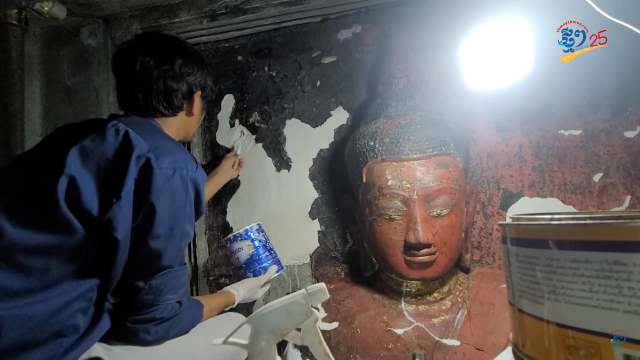Challenges and Success during the Restoration of Angkor Wat’s Bakan Tower

- By Hong Sreyna
- February 19, 2023 5:02 PM
SIEM REAP — The Bakan tower is one of the essential elements of Angkor Wat’s structure. When walking toward this magnificent monument, its five towers will gradually appear before our eyes. Then one can reach the top of this tower by climbing the very steep eastern flight of steps, which can prove an exciting as well as terrifying experience for some people due to the steps’ abrupt inclination.
Visitors rarely fail to visit the Bakan tower because, from this gallery, they can see the beautiful landscape that lies beyond Angkor Wat as well as other parts of the temple itself at its lower levels. The tower is also a sacred place due to its four Buddhist statues that people often come to worship and pray at their feet for their worries and problems to fade away.
_1676788287.png)
Unfortunately, being part of Angkor that was built in the early 12th century, the Bakan tower has been greatly affected by the elements as time went by. While restoration work was conducted by a French team nearly 70 years ago, the mortar used at the time has slowly disintegrated, leaving holes that enable leakage into the structure.
After seeing the weary state of the Bakan tower, the APSARA National Authority, which is the Cambodian government body managing the Angkor Archeological Park, studied the issue and submitted a report on its restoration project to experts—being a UNESCO World Heritage site, restoration projects at Angkor must be reviewed by an international team of experts. The project having obtained their authorization, the Cambodian team started on the project on Nov. 8, 2021.
As Kim Sothin, deputy director-general of APSARA, explained, “[f]irst of all, we have had to find the pieces of the missing stones because we are not allowed to use new ones for replacement.” Using stones that have been under different weather conditions than the initial ones could damage the tower’s stones, he said. “New stones can only be used in exceptional cases such as when needed to support an older structure.”
_1676788405.png)
During the first 10 months of the project, Sothin said, “our team has been really committed to this project, working tirelessly even on weekends. The only holidays that the team got were during public holidays since there were too many tourists.”
Click here to watch the content in Khmer
Due to the condition of several stones, the restoration project has involved replacing a number of sandstone and laterite stones with new ones. The laterite stones were to be used as the first layer, and then the sandstone ones put on the outside to cover the laterite layer. Even though the Bakan tower platform was in poor condition, the restoration experts insisted on using the original stones instead of newer ones to preserve the tower’s architectural authenticity.
Which is why the APSARA National Authority team has tried to find the pieces of the missing stones, hoping not to have to resort to replacement ones. As Kim Sothin explained, “new stones cannot simply be added or substituted. At the start of our project, the team had difficulties transporting the lost-and-found stones to the top [of the tower]. It took us about three days to transport a stone block to its original place. Then we discovered a better method of transportation, which makes it efficient and easier to carry seven to eight stones per day.”
_1676788461.png)
The other challenge was to put in place and secure the new stones on the existing structure, Sothin said. The team had to carefully study dimensions and movements to make sure that the stones would be properly braced for the additional restoration work. The stone transportation process and weather made the work even more difficult. “We encountered a lot of heavy rain,” Sothin said. “Therefore, we have had to move blocks of stone from high places safely to ground level. And this was challenging and nerve-wracking as well.”
Restoring the Bakan tower platform has required 60 people divided into groups of eight working on different tasks. This also involved buying equipment and materials plus renting a crane, Sothin said. But the most important element of the project, he said, has been these specialized workers who have not hesitated to climb up and down the Bakan tower, which can be quite dangerous and cannot be done by just any worker.
This has required workers who are both dedicated and patient. “The stone fragments left are problematic,” Sothin said. “We have to transfer them to ground level, and this can be time and energy-consuming considering the weight that we have to carry,” he said. “Therefore, after one or two trips up and down these stairs, the ones carrying and disposing of the pieces of stones left must already be tired.”
_1676788491.png)
In addition to the importance of this restoration project to preserve this historical monument, such projects play an important role in the training of restoration teams workers of the future, Sothin said. “It is a good thing that we are involved in this project because we can pass on these skills to the next persons and specifically teach them how to identify types of stone,” he said. In addition to helping to train workers to become specialized in this field, such projects contribute to creating employment in the region, he added.
And yet, as Kheam Mony—an engineer with APSARA Authority and the project’s general manager—pointed out, restoration workers at Angkor don’t just do it for the salary: They really care about making sure these temples at Angkor will remain standing for centuries, he said. The work also involves cooperation between archeologists, architects, engineers and other professionals as well as specialized craftsmen and workers to make sure these monuments and ancient structures will remain standing for generations to come, Mony said. “This is our nation’s pride and what we are doing is helping to safeguard Cambodia’s pride and legacy,” he said.
_1676788543.png)
According to Kim Sothin, the restoration work was delayed due to the COVID-19 pandemic and, more recently, because of budget consideration. However, it is due to resume in the coming months.
So, work on the eastern platform of the Bakan tower will start as soon as the APSARA Authority receives the go-ahead, he said. Sothin hopes that this will be as soon as possible in 2023 because this platform is significantly damaged, he said. So much so that, according to experts in the field, the eastern Bakan tower platform might have to be entirely deconstructed and then re-assembled to save time and effort.
_1676788614.png)
In addition to being essential as this will ensure the Bakan tower can remain standing for a very long time, the project has contributed to providing workers with employment at a time when the COVID-19 pandemic had forced projects to be postponed.
Originally written in Khmer for ThmeyThmey25, this story was translated by Song Daphea for Cambodianess















